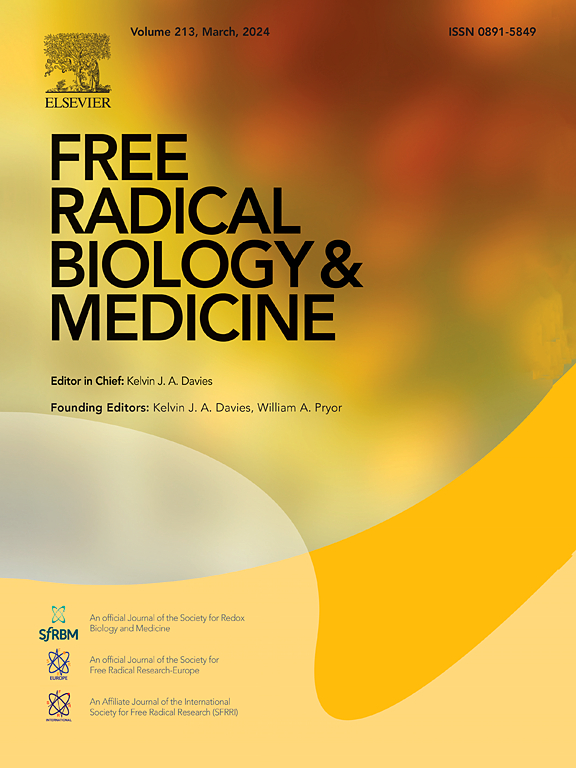n端胺的二甲基标记可以明确地识别蛋白质交联。
IF 7.1
2区 生物学
Q1 BIOCHEMISTRY & MOLECULAR BIOLOGY
引用次数: 0
摘要
通过有意的酶氧化或活性氧化剂(氧化应激/应激)诱导的蛋白质交联与多种人类疾病有关,包括动脉粥样硬化、阿尔茨海默病和帕金森病。在许多情况下,交联的性质、它们在多肽链内(分子内)或分子间(分子间)的位置以及浓度都不清楚。虽然从特异性抗体获得的数据有限,但蛋白质交联的详细表征通常是通过蛋白水解消化肽的质谱分析来完成的。这种分析是具有挑战性的,因为这些物种的浓度很低,而且与非交联物种相比,它们的片段离子谱很复杂。我们假设,使用“轻”和“重”同位素标记试剂,对交联肽中的两个n端进行高效和特异性的化学胺标记(与线性肽的单个n端相比),将有助于鉴定、验证和定量交联。该方法与之前酶催化的18O c末端羧酸标记方法进行了比较。与18o方法相比,n端胺二甲基标记具有主要优势,包括高标记率(92-100%)和定义良好的质谱同位素分布模式。该方法鉴定了氧化β-酪蛋白(Y195-Y195, Y195-Y208, Y208-Y208)和暴露于亚硝化胁迫的α-突触核蛋白(Y39-Y39, Y39-Y125, Y39-Y133, Y133-Y136)中对酪氨酸(Tyr, Y)残基之间的新型二酪氨酸交联。这种方法也适用于二硫键作图,血清白蛋白中17种二硫中的15种很容易检测到。这些数据表明,二甲基标记是一种高度通用和有效的方法,用于蛋白质中氧化和硝化诱导的交联的位点特异性鉴定。本文章由计算机程序翻译,如有差异,请以英文原文为准。

Dimethyl labeling of N-terminal amines allows unambiguous identification of protein crosslinks
Protein crosslinks induced through either deliberate enzymatic oxidation or reactive oxidants (oxidative eustress/distress), are associated with multiple human pathologies including atherosclerosis, Alzheimer's and Parkinson's diseases. In many cases, the nature of the crosslinks, their position(s) either within (intramolecular) or between (intermolecular) polypeptide chains, and concentrations are unclear. Although limited data are available from specific antibodies, detailed characterization of protein crosslinks is often performed by mass spectrometric analysis of peptides from proteolytic digestion. Such analyses are challenging due to the low concentration of these species, and the complexity of their fragment ion spectra when compared to non-crosslinked species. We hypothesized that highly efficient and specific chemical amine labeling of the two N-termini in crosslinked peptides (compared to the single N-terminus of linear peptides), using “light” and “heavy” isotope-labelled reagents would facilitate identification, validation and quantification of crosslinks. This method was compared to a previous enzyme-catalyzed 18O C-terminal carboxylate labeling approach. N-terminal amine dimethyl labeling is shown to have major advantages over the 18O-approach including high labeling yields (92–100 %) and well-defined mass spectrometric isotope distribution patterns. This approach has allowed identification of novel dityrosine crosslinks between pair of tyrosine (Tyr, Y) residues in photo-oxidized β-casein (Y195-Y195, Y195-Y208, Y208-Y208), and α-synuclein exposed to nitrosative stress (Y39-Y39, Y39-Y125, Y39-Y133, Y133-Y136). This approach is also applicable to disulfide bond mapping, with 15 of 17 disulfides in serum albumin readily detected. These data indicate that dimethyl labeling is a highly versatile and efficient approach for the site-specific identification of oxidation- and nitration-induced crosslinks in proteins.
求助全文
通过发布文献求助,成功后即可免费获取论文全文。
去求助
来源期刊

Free Radical Biology and Medicine
医学-内分泌学与代谢
CiteScore
14.00
自引率
4.10%
发文量
850
审稿时长
22 days
期刊介绍:
Free Radical Biology and Medicine is a leading journal in the field of redox biology, which is the study of the role of reactive oxygen species (ROS) and other oxidizing agents in biological systems. The journal serves as a premier forum for publishing innovative and groundbreaking research that explores the redox biology of health and disease, covering a wide range of topics and disciplines. Free Radical Biology and Medicine also commissions Special Issues that highlight recent advances in both basic and clinical research, with a particular emphasis on the mechanisms underlying altered metabolism and redox signaling. These Special Issues aim to provide a focused platform for the latest research in the field, fostering collaboration and knowledge exchange among researchers and clinicians.
 求助内容:
求助内容: 应助结果提醒方式:
应助结果提醒方式:


